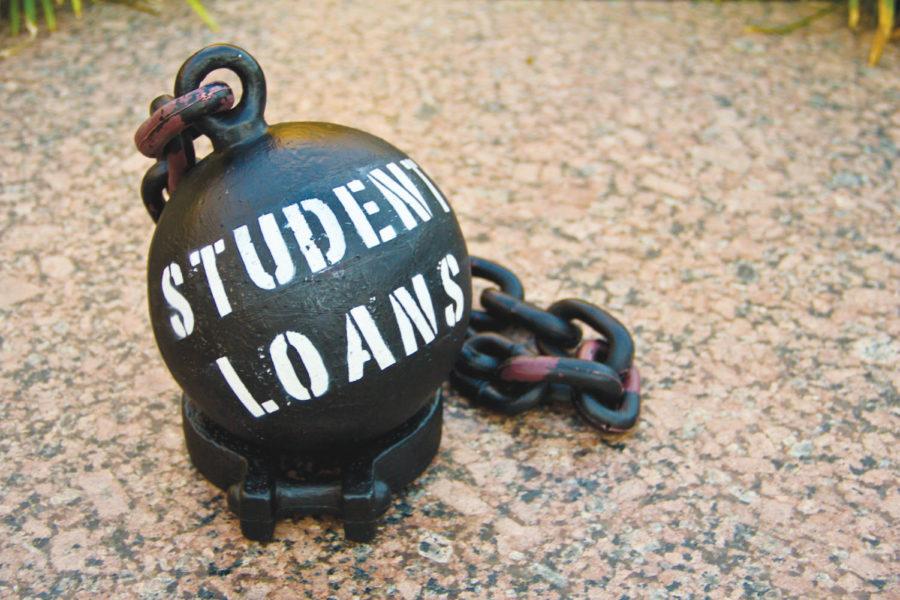Stoffa: Student loans need to be eligible for bankruptcy
Financial debt can be a major strain on graduates, especially when bankruptcy is not an option for student loans.
February 19, 2013
Many college students across the nation have been receiving letters of notification in the mail concerning their student loans. The federal government is informing students that their college loans were handed over to Sallie Mae.
Sallie Mae has been one of the largest private education loan providers for years, assisting students whose federal loans are not enough and that are subsequently without any other options to finance their education.
Though interest rates can be somewhat intimidating, the assumed value of the education to be had should cover the loans themselves and interest. Traditionally, that nifty piece of paper your parents are so proud of was a ticket to ride the job market.
And I’ll tell you something: The number of students in need of assistance beyond federal loans is increasing. Especially given the high number of families already still repaying their student loans and hence unable to contribute the ridiculous factored numbers for assistance they are “supposed” to contribute, as seemingly pulled out of the air by the current federal loan system.
And then we are coming to realize education qualification is not what it used to be.
A college degree is likely to get you a job nowadays over the bloke without a nifty piece of accredited paper, but that job isn’t necessarily going to pay enough money to cover your expenses and allow you much petty cash or money to save for a family down the line.
College is encouraged for everyone, and higher education betters the entire country, of that there is little doubt. The quality of the education and the choice of students as to whether they actively try to learn and grow or merely slide by is another situation entirely.
In any case, students are leaving the marvelously fun and relatively easy, comparatively, college life and donning their big-boy or big-girl pants to compete in the “real” world.
Living in that real world comes with a lot of responsibility compared to college life, where a lot of students still had mommy or daddy to reach out to when they screwed up. Common real-world expenses that are all on the newly graduated individual alone include: housing fees, food, medical, general utilities, clothing and other household items, Internet and cell phone, car maintenance, planning for families, unforeseen events, a bit of entertainment, and oh yeah, this one is usually the biggie: student loans.
The real world tends to pay most newcomers bottom-of-the-barrel salaries or hourly wages. During his fifth State of the Union Address, President Barack Obama proposed moving the minimum wage up to $9 per hour.
Just so you know, $9 per hour at a 40-hour-a-week job, four weeks a month, 12 full months of the year is $17,280 before taxes. The federal poverty guideline as of 2012 for a single person is $11,170.
But let’s say your diploma does what it is supposed to do right out of college and you land something a little better: Working 40 hours a week, four full weeks out of the month, 12 full months a year at $15 an hour is the same as a salary of $28,800, and that is before any taxes. Looking at the Statistical Abstract for the 2012 U.S. Census Bureau, about one-third of households make that much or less.
The debt for an average student — four years in college for a bachelor’s degree — freshly graduated is $27,000. The Stafford Loans many students have are at 6.8 percent interest and set for repayment over 10 years. Just using those numbers, a student’s interest is $10,285.87 with monthly payments of $310.72 or $3,728.64 per year.
So let me tell you, bubba: $28,800 does not cut it if you want to be more than a workhorse well into your twilight years; and possibly still then.
But hey, everyone knows a college degree guarantees you make more than that with nary a risk of not having the perfect 40 hours a week every single week out of the year without a break, right? (#sarcasm)
Before 2005, if the weight of the world fell too hard on a student’s shoulders they could file bankruptcy before their private student loan payments crushed them. Then the Bankruptcy Abuse Prevention and Consumer Protection Act eliminated even those from potential discharge.
With time comes wisdom, and the need for that safety net might now be at hand again. The Fairness for Struggling Students Act was proposed in 2013 to put student loans not made, insured, funded or guaranteed under a government program back into the bankruptcy system.
And even those federal loans not under the proposed umbrella can be discharged with certain provisions provided under public service.
This isn’t to say bankruptcy is a get-out-of-jail-free card, and shouldn’t be used as such — nor would it be that simple — but it would give students an option if life seems jolly rotten before the urge to laugh and smile and dance and sing is snuffed out.
Even Sallie Mae is “not opposed to bankruptcy protection for student loans, provided that it applies to all student loans and there is some sort of good faith attempt at payment for five or six years” according to a Forbes interview with John F. “Jack” Remondi, president and chief operating officer of Sallie Mae.
Maybe with the recent changing of hands of many students’ loans to Sallie Mae’s purview there will be a different assessment of whether those are included in possible bankruptcy situations; we can let lawyers figure that out down the line.
With that in mind, you should contact your representatives to let them know you support the Fairness for Struggling Students Act of 2013. Maybe you won’t need it, maybe you will, maybe it will help someone you know or even someone you haven’t met yet that you want to share your life, and financial plights, with.
Whatever the reason, with low starting pay and a challenging job market already in place, having some kind of safety net in place for those still struggling terribly under student loans after six or so years is a logical idea to back.
——————————————————————————————-
Gabriel Stoffa is a graduate student in political science from Ottumwa, Iowa.

















